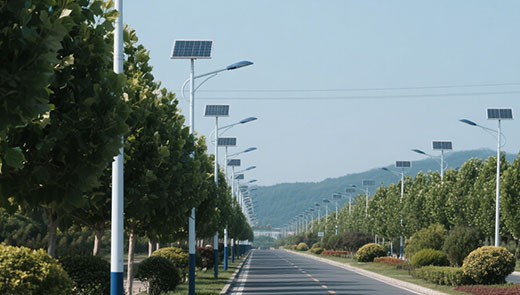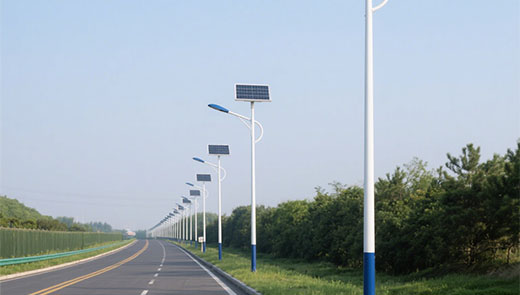The Uses and Importance of Road Studs
Oct 23, 2024
Road Studs, also known as road marking Studs or reflective road Studs, are vital safety facilities in road traffic management. They are not only used to mark lanes and road boundaries, but also to improve road visibility at night or in bad weather conditions to ensure the safety of drivers. The use of road Studs is extremely common on various highways, bridges, tunnels and dangerous sections around the world. It is an important means to improve road safety and reduce traffic accidents. This article will introduce in detail the functions of road Studs and their specific uses in road safety.
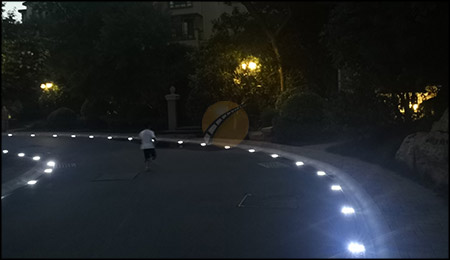 Solar road studs: This type of road stud has built-in solar panels and LED lights, which store solar energy during the day and automatically emit light at night. It can provide clear road guidance even in extreme weather and is suitable for roads with long-term insufficient lighting conditions.
Solar road studs: This type of road stud has built-in solar panels and LED lights, which store solar energy during the day and automatically emit light at night. It can provide clear road guidance even in extreme weather and is suitable for roads with long-term insufficient lighting conditions.
White road studs: used to mark lane dividers, usually installed in the center of the road or between lanes.
Yellow road studs: usually installed in the middle of a two-way lane to remind drivers not to cross the line.
Red road studs: used to warn prohibited areas and remind drivers not to enter certain specific areas or reverse lanes.
Green road studs: often used to mark emergency exits or emergency lanes to help drivers quickly find exits or safe passages.
Through these colored road studs, drivers can intuitively understand the type of the current lane and the direction of travel, greatly reducing traffic accidents caused by drivers misjudging the road.
In sharp bends and downhill sections, reflective road studs or solar road studs with warning functions are set up to clearly indicate the danger ahead, thereby reducing accidents caused by speeding or misjudgment of the route.
In construction sections or narrow roads, the color and arrangement of road studs can clearly indicate changes in road conditions ahead of the vehicle, helping drivers to adjust their speed and driving trajectory in time.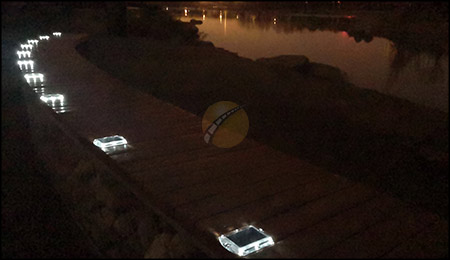 Reduced accident rate during nighttime driving: When driving at night, road studs provide necessary visual cues to help drivers better judge the direction of the road, the position of the lane and the obstacles ahead, significantly reducing the incidence of nighttime traffic accidents.
Reduced accident rate during nighttime driving: When driving at night, road studs provide necessary visual cues to help drivers better judge the direction of the road, the position of the lane and the obstacles ahead, significantly reducing the incidence of nighttime traffic accidents.
Driving safety in bad weather: Bad weather such as heavy fog, heavy rain, and snow can seriously reduce the visibility of drivers, leading to a high incidence of accidents. In this case, roads equipped with road studs can provide drivers with clearer visual guidance and effectively avoid accidents.
The role of road studs in this case is particularly important. They can not only reduce the probability of vehicles deviating from the lane, but also reduce the risk of serious traffic accidents such as rear-end collisions and skidding.
Application in tunnels: In long tunnels, the light is poor and drivers are prone to visual fatigue. Road studs can help drivers maintain the correct driving path and avoid hitting the tunnel wall or other vehicles through continuous light sources or reflective effects.
Divergence and merging prompts: At the merging or diverging points of lanes, road studs can change color or flash to remind drivers that the lane ahead is about to change, helping drivers drive smoothly.
Reflective road studs: Reflective road studs are mostly made of high-strength plastics, aluminum alloys or glass, with highly reflective materials embedded inside. When illuminated by vehicle lights, they can reflect light back to the driver's sight. Reflective road studs are often used in low-cost, high-traffic roads, especially on highways and urban main roads.
Solar road stud lights: Solar road studs are equipped with solar panels and LED lights inside, which can absorb solar energy during the day and automatically emit light at night. They work best on sections of road where there is no light for a long time, and are suitable for rural roads, mountain roads or coastal roads.
Regardless of the type of road studs, their materials and designs must be able to withstand high pressure on the road, frequent vehicle rolling and adverse weather conditions.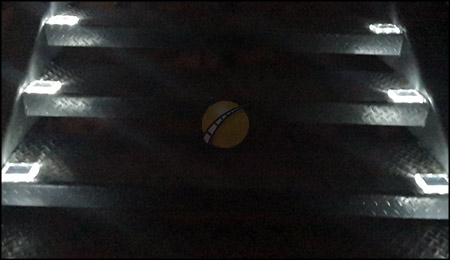
As a simple and efficient road safety facility, road studs have been widely used around the world. They can not only improve road visibility and help drivers maintain the correct driving trajectory at night or in bad weather, but also effectively reduce traffic accidents. Road studs of different colors and types provide a variety of functions according to different road conditions. From lane separation, danger warnings to nighttime guidance, they play a vital role in road safety management.
In the future, with the intelligent development of road traffic, road studs may be combined with intelligent transportation systems to provide more comprehensive road information and safety prompts, making their role in ensuring road safety more prominent.
1. Improve road visibility
The most direct effect of road Studs is to improve road visibility, especially at night or in low visibility conditions. Traditional road markings are difficult to see at night or in foggy, rainy or snowy weather. Road Studs reflect the light of vehicle headlights or actively emit light to help drivers see lane boundaries and road directions more clearly, avoiding mistaken entry into adjacent lanes or driving off the road.Reflective Road Studs: Road Studs are embedded with highly reflective materials. When the light of the vehicle shines on the surface of the road Studs, the reflective material will reflect the light back to the driver's sight. Even in the absence of street lights, the reflective effect of road studs is still very obvious, which can provide driving guidance for drivers.

2. Marking lanes and boundaries
Road studs are often used to mark lane lines, road edges and center lines to help drivers stay in the correct lane. On highways, urban expressways or rural roads, road studs can clearly mark the dividing lines between lanes and the boundaries of the road, which is especially important when there are no street lights or the markings are difficult to identify.White road studs: used to mark lane dividers, usually installed in the center of the road or between lanes.
Yellow road studs: usually installed in the middle of a two-way lane to remind drivers not to cross the line.
Red road studs: used to warn prohibited areas and remind drivers not to enter certain specific areas or reverse lanes.
Green road studs: often used to mark emergency exits or emergency lanes to help drivers quickly find exits or safe passages.
Through these colored road studs, drivers can intuitively understand the type of the current lane and the direction of travel, greatly reducing traffic accidents caused by drivers misjudging the road.
3. Warning of dangerous areas
Solar-powered Road studs not only play a role on ordinary roads, but are also used for warning and marking dangerous sections. For example, road studs can play a significant reminder role in places with limited vision such as bends, ramps, bridge entrances or tunnel exits. Through their reflective or luminous effects, they remind drivers to be alert and slow down when entering these special sections.In sharp bends and downhill sections, reflective road studs or solar road studs with warning functions are set up to clearly indicate the danger ahead, thereby reducing accidents caused by speeding or misjudgment of the route.
In construction sections or narrow roads, the color and arrangement of road studs can clearly indicate changes in road conditions ahead of the vehicle, helping drivers to adjust their speed and driving trajectory in time.
4. Reduce traffic accidents
Since road studs can significantly improve road visibility under various light conditions and clearly mark road boundaries and dangerous areas, their role in reducing traffic accidents cannot be ignored.
Driving safety in bad weather: Bad weather such as heavy fog, heavy rain, and snow can seriously reduce the visibility of drivers, leading to a high incidence of accidents. In this case, roads equipped with road studs can provide drivers with clearer visual guidance and effectively avoid accidents.
The role of road studs in this case is particularly important. They can not only reduce the probability of vehicles deviating from the lane, but also reduce the risk of serious traffic accidents such as rear-end collisions and skidding.
5. Guidance and prompting functions
In addition to the basic functions of reflection and illumination, road studs also have obvious guidance functions. In complex road traffic systems, road studs can be used to guide vehicles to drive correctly and avoid entering the wrong lane or direction. Especially at large intersections, roundabouts or multi-lane highways, road studs clearly indicate the direction of travel and the correct exit of vehicles through different colors and arrangements.Application in tunnels: In long tunnels, the light is poor and drivers are prone to visual fatigue. Road studs can help drivers maintain the correct driving path and avoid hitting the tunnel wall or other vehicles through continuous light sources or reflective effects.
Divergence and merging prompts: At the merging or diverging points of lanes, road studs can change color or flash to remind drivers that the lane ahead is about to change, helping drivers drive smoothly.
6. Classification and materials of road studs
Depending on the materials and functions, road studs can be divided into many types, among which reflective road studs and solar road studs are the most common.Reflective road studs: Reflective road studs are mostly made of high-strength plastics, aluminum alloys or glass, with highly reflective materials embedded inside. When illuminated by vehicle lights, they can reflect light back to the driver's sight. Reflective road studs are often used in low-cost, high-traffic roads, especially on highways and urban main roads.
Solar road stud lights: Solar road studs are equipped with solar panels and LED lights inside, which can absorb solar energy during the day and automatically emit light at night. They work best on sections of road where there is no light for a long time, and are suitable for rural roads, mountain roads or coastal roads.
Regardless of the type of road studs, their materials and designs must be able to withstand high pressure on the road, frequent vehicle rolling and adverse weather conditions.

As a simple and efficient road safety facility, road studs have been widely used around the world. They can not only improve road visibility and help drivers maintain the correct driving trajectory at night or in bad weather, but also effectively reduce traffic accidents. Road studs of different colors and types provide a variety of functions according to different road conditions. From lane separation, danger warnings to nighttime guidance, they play a vital role in road safety management.
In the future, with the intelligent development of road traffic, road studs may be combined with intelligent transportation systems to provide more comprehensive road information and safety prompts, making their role in ensuring road safety more prominent.

